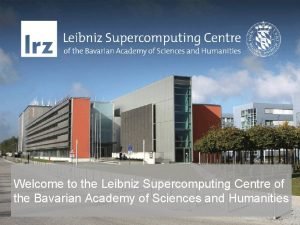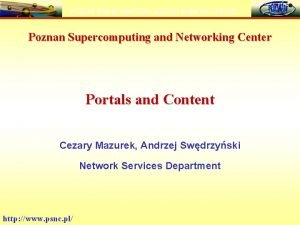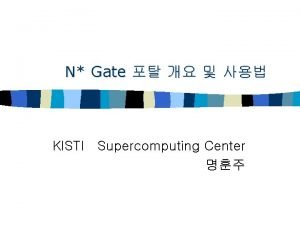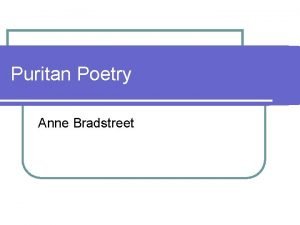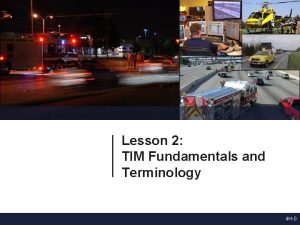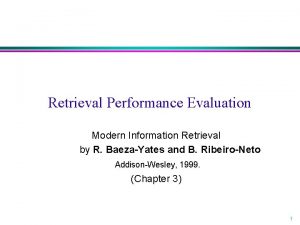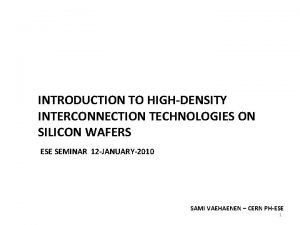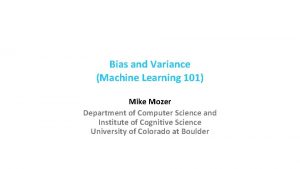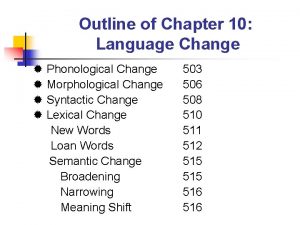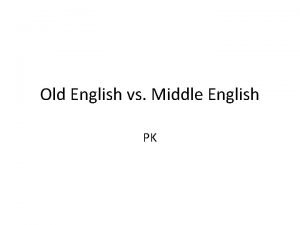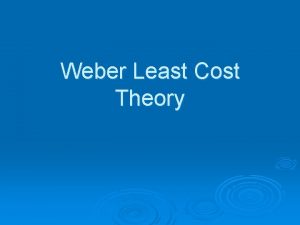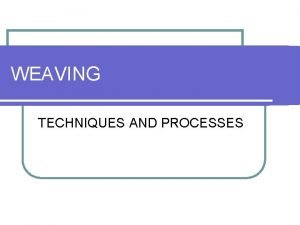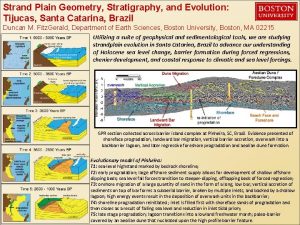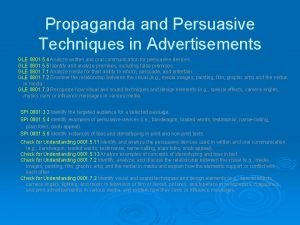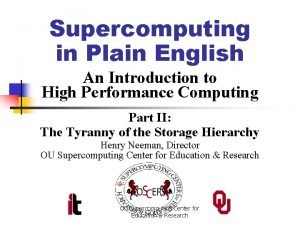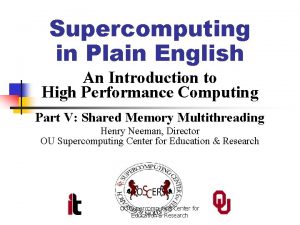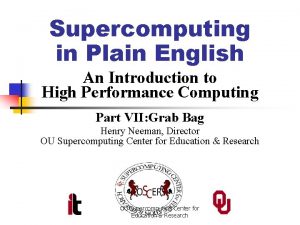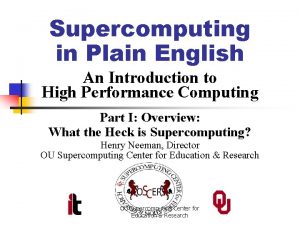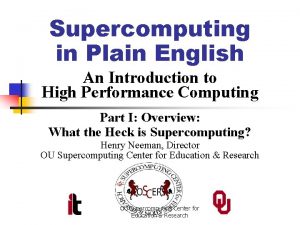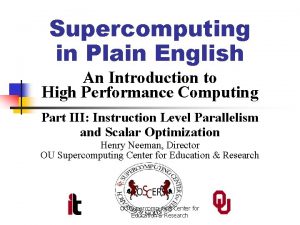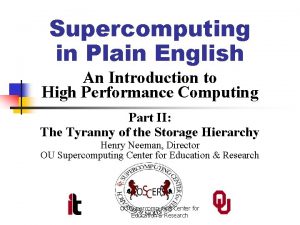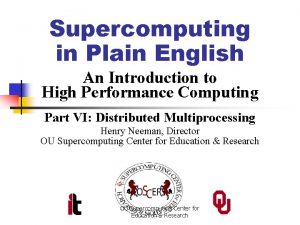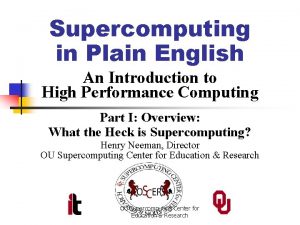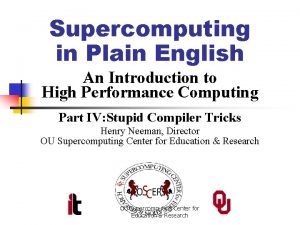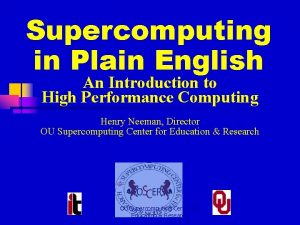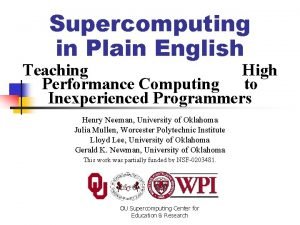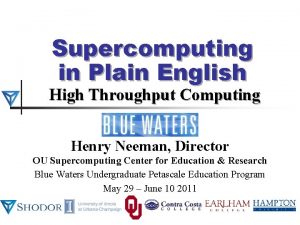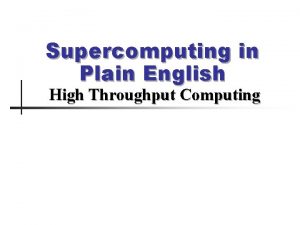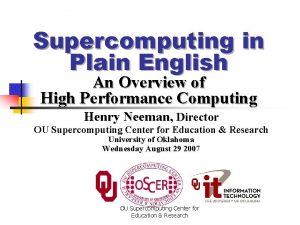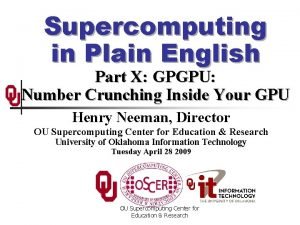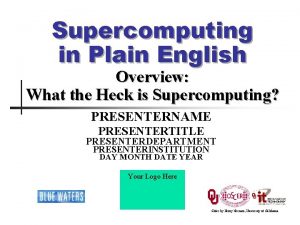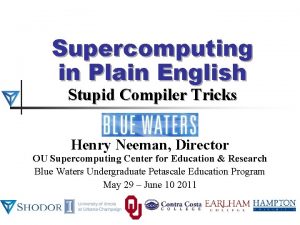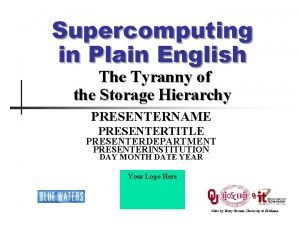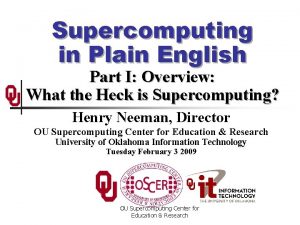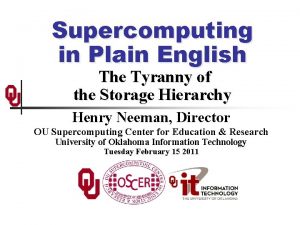Supercomputing in Plain English An Introduction to High

























































![References [1] Kevin Dowd and Charles Severance, High Performance Computing, 2 nd ed. O’Reilly, References [1] Kevin Dowd and Charles Severance, High Performance Computing, 2 nd ed. O’Reilly,](https://slidetodoc.com/presentation_image/de6b375801f3978ec7e500f6e7916d05/image-58.jpg)
- Slides: 58

Supercomputing in Plain English An Introduction to High Performance Computing Part IV: Stupid Compiler Tricks Henry Neeman, Director OU Supercomputing Center for Education & Research

Outline n n Dependency Analysis n What is Dependency Analysis? n Control Dependencies n Data Dependencies Stupid Compiler Tricks n Tricks the Compiler Plays n Tricks You Play With the Compiler n Profiling OU Supercomputing Center for Education & Research 2

Dependency Analysis OU Supercomputing Center for Education & Research

What Is Dependency Analysis? Dependency analysis is the determination of how different parts of a program interact, and how various parts require other parts in order to operate correctly. A control dependency governs how different routines or sets of instructions affect each other. A data dependency governs how different pieces of data affect each other. Much of this discussion is from references [1] and [5]. OU Supercomputing Center for Education & Research 4

Control Dependencies Every program has a well-defined flow of control. This flow can be affected by several kinds of operations: n Loops n Branches (if, select case/switch) n Function/subroutine calls n I/O (typically implemented as calls) Dependencies affect parallelization! OU Supercomputing Center for Education & Research 5

Branch Dependency Example y = 7 IF (x /= 0) THEN y = 1. 0 / x END IF !! (x /= 0) The value of y depends on what the condition (x /= 0) evaluates to: n If the condition evaluates to. TRUE. , then y is set to 1. 0/x. n Otherwise, y remains 7. OU Supercomputing Center for Education & Research 6

Loop Dependency Example DO index = 2, length a(index) = a(index-1) + b(index) END DO !! index = 2, length Here, each iteration of the loop depends on the previous iteration. That is, the iteration i=3 depends on iteration i=2, iteration i=4 depends on i=3, iteration i=5 depends on i=4, etc. This is sometimes called a loop carried dependency. OU Supercomputing Center for Education & Research 7

Why Do We Care? Loops are the favorite control structures of High Performance Computing, because compilers know how to optimize them using instructionlevel parallelism: superscalar and pipelining give excellent speedup. Loop carried dependencies affect whether a loop can be parallelized, and how much. OU Supercomputing Center for Education & Research 8

Loop or Branch Dependency? Is this a loop carried dependency or an IF dependency? DO index = 1, length IF (x(index) /= 0) THEN y(index) = 1. 0 / x(index) END IF !! (x(index) /= 0) END DO !! index = 1, length OU Supercomputing Center for Education & Research 9

Call Dependency Example x = 5 y = myfunction(7) z = 22 The flow of the program is interrupted by the call to myfunction, which takes the execution to somewhere else in the program. OU Supercomputing Center for Education & Research 10

I/O Dependency X = a + b PRINT *, x Y = c + d Typically, I/O is implemented by implied subroutine calls, so we can think of this as a call dependency. OU Supercomputing Center for Education & Research 11

Reductions sum = 0 DO index = 1, length sum = sum + array(index) END DO !! index = 1, length Other kinds of reductions: product, . AND. , . OR. , minimum, maximum, index of minimum, index of maximum, number of occurrences, etc. Reductions are so common that hardware and compilers are optimized to handle them. Also, they aren’t really dependencies, because the order in which the individual operations are performed doesn’t matter. OU Supercomputing Center for Education & Research 12

Data Dependencies a = x + y + COS(z) b = a * c The value of b depends on the value of a, so these two statements must be executed in order. OU Supercomputing Center for Education & Research 13

Output Dependencies x = a / b y = x + 2 x = d - e Notice that x is assigned two different values, but only one of them is retained after these statements. In this context, the final value of x is the “output. ” Again, we are forced to execute in order. OU Supercomputing Center for Education & Research 14

Why Does Order Matter? n n Dependencies can affect whether we can execute a particular part of the program in parallel. If we cannot execute that part of the program in parallel, then it’ll be SLOW OU Supercomputing Center for Education & Research 15

Loop Dependency Example if ((dst == src 1) && (dst == src 2)) { for (index = 1; index < length; index++) { dst[index] = dst[index-1] + dst[index]; } /* for index */ } /* if ((dst == src 1) && (dst == src 2)) */ else if (dst == src 1) { for (index = 1; index < length; index++) { dst[index] = dst[index-1] + src 2[index]; } /* for index */ } /* if (dst == src 1) */ … OU Supercomputing Center for Education & Research 16

Loop Dep Example (cont’d) … else { for (index = 1; index < length; index++) { dst[index] = src 1[index-1]+src 2[index]; } /* for index */ } /* if (dst == src 2). . . else */ The various versions of the loop either: n do have loop carried dependencies, or n do not have loop carried dependencies. OU Supercomputing Center for Education & Research 17

Loop Dependency Performance OU Supercomputing Center for Education & Research 18

Stupid Compiler Tricks OU Supercomputing Center for Education & Research

Stupid Compiler Tricks n n Tricks Compilers Play n Scalar Optimizations n Loop Optimizations n Inlining Tricks You Can Play with Compilers OU Supercomputing Center for Education & Research 20

Compiler Design The people who design compilers have a lot of experience working with the languages commonly used in High Performance Computing: n Fortran: 45 ish years n C: 30 ish years n C++: 15 ish years, plus C experience So, they’ve come up with clever ways to make programs run faster. OU Supercomputing Center for Education & Research 21

Tricks Compilers Play OU Supercomputing Center for Education & Research

Scalar Optimizations Copy Propagation n Constant Folding n Dead Code Removal n Strength Reduction n Common Subexpression Elimination n Variable Renaming Not every compiler does all of these, so it sometimes can be worth doing these by hand. n Much of this discussion is from [2] and [5]. OU Supercomputing Center for Education & Research 23

Copy Propagation Before x = y z = 1 + x Has data dependency Compile After x = y z = 1 + y No data dependency OU Supercomputing Center for Education & Research 24

Constant Folding After Before add = 100 aug = 200 sum = add + aug sum = 300 Notice that sum is actually the sum of two constants, so the compiler can precalculate it, eliminating the addition that otherwise would be performed at runtime. OU Supercomputing Center for Education & Research 25

Dead Code Removal Before After var = 5 PRINT *, var STOP PRINT *, var * 2 var = 5 PRINT *, var STOP Since the last statement never executes, the compiler can eliminate it. OU Supercomputing Center for Education & Research 26

Strength Reduction Before x = y ** 2. 0 a = c / 2. 0 After x = y * y a = c * 0. 5 Raising one value to the power of another, or dividing, is more expensive than multiplying. If the compiler can tell that the power is a small integer, or that the denominator is a constant, it’ll use multiplication instead. OU Supercomputing Center for Education & Research 27

Common Subexpressions Before d = c*(a+b) e = (a+b)*2. 0 After aplusb = a + b d = c*aplusb e = aplusb*2. 0 The subexpression (a+b) occurs in both assignment statements, so there’s no point in calculating it twice. OU Supercomputing Center for Education & Research 28

Variable Renaming Before x = y * z q = r + x * 2 x = a + b After x 0 = y * z q = r + x 0 * 2 x = a + b The original code has an output dependency, while the new code doesn’t – but the final value of x is still correct. OU Supercomputing Center for Education & Research 29

Loop Optimizations Hoisting Loop Invariant Code n Unswitching n Iteration Peeling n Index Set Splitting n Loop Interchange n Unrolling n Loop Fusion n Loop Fission Not every compiler does all of these , so it sometimes can be worth doing these by hand. n Much of this discussion is from [3] and [5]. OU Supercomputing Center for Education & Research 30

Hoisting Loop Invariant Code DO i = 1, n Code that a(i) = b(i) + c * d Before doesn’t e = g(n) change inside END DO !! i = 1, n the loop is called loop invariant. It temp = c * d doesn’t need DO i = 1, n to be After a(i) = b(i) + temp calculated END DO !! i = 1, n over and over. e = g(n) OU Supercomputing Center for Education & Research 31

Unswitching DO i = 1, n DO j = 2, n IF (t(i) > 0) THEN The condition is j-independent. a(i, j) = a(i, j) * t(i) + b(j) ELSE !! (t(i) > 0) a(i, j) = 0. 0 Before END IF !! (t(i) > 0)…ELSE END DO !! j = 2, n END DO !! i = 1, n DO i = 1, n IF (t(i) > 0) THEN So, it can migrate outside the j loop. DO j = 2, n a(i, j) = a(i, j) * t(i) + b(j) END DO !! j = 2, n ELSE !! (t(i) > 0) After DO j = 2, n a(i, j) = 0. 0 END DO !! j = 2, n END IF !! (t(i) > 0)…ELSE END DO !! i = 1, n OU Supercomputing Center for Education & Research 32

Iteration Peeling Before DO i = 1, n IF ((i == 1). OR. (i == n)) THEN x(i) = y(i) ELSE x(i) = y(i + 1) + y(i – 1) END IF END DO We can eliminate the IF by peeling the weird iterations. After x(1) = DO i = x(i) END DO x(n) = y(1) 2, n - 1 = y(i + 1) + y(i – 1) y(n) OU Supercomputing Center for Education & Research 33

Index Set Splitting DO i = 1, n a(i) = b(i) + c(i) IF (i > 10) THEN d(i) = a(i) + b(i – 10) Before END IF !! (i > 10) END DO !! i = 1, n DO i = a(i) END DO DO i = a(i) d(i) END DO 1, 10 = b(i) !! i = 11, n = b(i) = a(i) !! i = + c(i) 1, n After + c(i) + b(i – 10) 1, n Note that this is a generalization of peeling. OU Supercomputing Center for Education & Research 34

Loop Interchange After Before DO i = 1, ni DO j = 1, nj a(i, j) = b(i, j) END DO !! j END DO !! i DO j = 1, nj DO i = 1, ni a(i, j) = b(i, j) END DO !! i END DO !! j Array elements a(i, j) and a(i+1, j) are near each other in memory, while a(i, j+1) may be far, so it makes sense to make the i loop be the inner loop. OU Supercomputing Center for Education & Research 35

Unrolling DO i = 1, n Before a(i) = a(i)+b(i) END DO !! i DO i = 1, n, 4 a(i) = a(i)+b(i) a(i+1) = a(i+1)+b(i+1) After a(i+2) = a(i+2)+b(i+2) a(i+3) = a(i+3)+b(i+3) END DO !! i You generally shouldn’t unroll by hand. OU Supercomputing Center for Education & Research 36

Why Do Compilers Unroll? We saw last time that a loop with a lot of operations gets better performance (up to some point), especially if there are lots of arithmetic operations but few main memory loads and stores. Unrolling creates multiple operations that typically load from the same, or adjacent, cache lines. So, an unrolled loop has more operations without increasing the memory accesses much. Also, unrolling decreases the number of comparisons on the loop counter variable, and the number of branches to the top of the loop. OU Supercomputing Center for Education & Research 37

Loop Fusion DO i = a(i) END DO DO i = c(i) END DO DO i = d(i) END DO 1, n = b(i) + 1 !! i = 1, n = a(i) / 2 !! i = 1, n = 1 / c(i) !! i = 1, n Before DO i = a(i) c(i) d(i) END DO 1, n = b(i) + 1 = a(i) / 2 = 1 / c(i) !! i = 1, n After As with unrolling, this has fewer branches. OU Supercomputing Center for Education & Research 38

Loop Fission DO i = a(i) c(i) d(i) END DO 1, n = b(i) + 1 = a(i) / 2 = 1 / c(i) !! i = 1, n Before DO i = a(i) END DO DO i = c(i) END DO DO i = d(i) END DO 1, n = b(i) + 1 !! i = 1, n = a(i) / 2 !! i = 1, n = 1 / c(i) !! i = 1, n After Fission reduces the cache load and the number of operations per iteration. OU Supercomputing Center for Education & Research 39

To Fuse or to Fiss? The question of when to perform fusion versus when to perform fission, like many optimization questions, is highly dependent on the application, the platform and a lot of other issues that get very, very complicated. Compilers don’t always make the right choices. That’s why it’s important to examine the actual behavior of the executable. OU Supercomputing Center for Education & Research 40

Inlining Before DO i = 1, n a(i) = func(i) END DO … REAL FUNCTION func (x) … func = x * 3 END FUNCTION func After DO i = 1, n a(i) = i * 3 END DO When a function or subroutine is inlined, its contents are transferred directly into the calling routine, eliminating the overhead of making the call. OU Supercomputing Center for Education & Research 41

Tricks You Can Play with Compilers OU Supercomputing Center for Education & Research

The Joy of Compiler Options Every compiler has a different set of options that you can set. Among these are options that control single processor optimization: superscalar, pipelining, vectorization, scalar optimizations, loop optimizations, inlining and so on. OU Supercomputing Center for Education & Research 43

Example Compile Lines n n n n IBM Regatta xlf 90 –O –qmaxmem=-1 –qarch=auto –qtune=auto –qcache=auto –qhot Intel ifc –O –x. W –tpp 7 Portland Group f 90 pgf 90 -O 2 –Mdalign –Mvect=assoc NAG f 95 –O 4 –Ounsafe –ieee=nonstd SGI Origin 2000 f 90 –Ofast –ipa Sun Ultra. SPARC f 90 –fast Cray. J 90 f 90 –O 3, aggress, pattern, recurrence OU Supercomputing Center for Education & Research 44

What Does the Compiler Do? Example: NAG f 95 compiler f 95 –O<level> source. f 90 Possible levels are –O 0, -O 1, -O 2, -O 3, -O 4: -O 0 No optimisation. … -O 1 Minimal quick optimisation. -O 2 Normal optimisation. -O 3 Further optimisation. -O 4 Maximal optimisation. [4] The man page is pretty cryptic. OU Supercomputing Center for Education & Research 45

Optimization Performance OU Supercomputing Center for Education & Research 46

More Optimized Performance OU Supercomputing Center for Education & Research 47

Profiling OU Supercomputing Center for Education & Research

Profiling means collecting data about how a program executes. The two major kinds of profiling are: n Subroutine profiling n Hardware timing OU Supercomputing Center for Education & Research 49

Subroutine Profiling Subroutine profiling means finding out how much time is spent in each routine. Typically, a program spends 90% of its runtime in 10% of the code. Subroutine profiling tells you what parts of the program to spend time optimizing and what parts you can ignore. Specifically, at regular intervals (e. g. , every millisecond), the program takes note of what instruction it’s currently on. OU Supercomputing Center for Education & Research 50

Profiling Example On the IBM Regatta: xlf 90 –O –pg … The –pg option tells the compiler to set the executable up to collect profiling information. Running the executable generates a file named gmon. out, which contains the profiling information. OU Supercomputing Center for Education & Research 51

Profiling Example (cont’d) When the run has completed, a file named gmon. out has been generated. Then: gprof executable produces a list of all of the routines and how much time was spent in each. OU Supercomputing Center for Education & Research 52

Profiling Result % cumulative time seconds 27. 6 52. 72 24. 3 99. 06 7. 9 114. 19 7. 2 127. 94 4. 7 136. 91 4. 1 144. 79 3. 9 152. 22 2. 3 156. 65 2. 2 160. 77 1. 7 163. 97 1. 5 166. 79 1. 4 169. 53 1. 3 172. 00 1. 2 174. 27 1. 0 176. 13 0. 9 177. 94 . . . self seconds 52. 72 46. 35 15. 13 13. 75 8. 96 7. 88 7. 43 4. 12 3. 20 2. 82 2. 74 2. 47 2. 27 1. 86 1. 81 calls 480000 897 300 299 300 300 897 300 300 300 480000 299 300 self ms/call 0. 11 51. 67 50. 43 45. 98 29. 88 26. 27 24. 77 4. 94 13. 73 10. 66 9. 40 9. 13 8. 23 0. 00 6. 22 6. 04 total ms/call 0. 11 51. 67 50. 43 45. 98 29. 88 31. 52 212. 36 56. 61 24. 39 10. 66 9. 40 9. 13 15. 33 0. 12 177. 45 6. 04 name longwave_ [5] mpdata 3_ [8] turb_ [9] turb_scalar_ [10] advect 2_z_ [12] cloud_ [11] radiation_ [3] smlr_ [7] tke_full_ [13] shear_prod_ [15] rhs_ [16] advect 2_xy_ [17] poisson_ [14] long_wave_ [4] advect_scalar_ [6] buoy_ [19] OU Supercomputing Center for Education & Research 53

Hardware Timing In addition to learning about which routines dominate in your program, you might also want to know how the hardware behaves; e. g. , you might want to know how often you get a cache miss. Many supercomputer CPUs have special hardware that measures such events, called event counters. OU Supercomputing Center for Education & Research 54

Hardware Timing Example On SGI Origin 2000: perfex –x –a executable This command produces a list of hardware counts. OU Supercomputing Center for Education & Research 55

Hardware Timing Results Cycles. . . 1350795704000 Decoded instructions. . . 1847206417136 Decoded loads. . . . . 448877703072 Decoded stores. . . . . 76766538224 Grad floating point instructions. . . 575482548960 Primary data cache misses. . 36090853008 Secondary data cache misses. . . 5537223904. . . This hardware counter profile shows that only 1% of memory accesses resulted in L 2 cache misses, which is good, but that it only got 0. 42 FLOPs per cycle, out of a peak of 2 FLOPs per cycle, which is bad. OU Supercomputing Center for Education & Research 56

Next Time Part V: Shared Memory Multithreading OU Supercomputing Center for Education & Research 57
![References 1 Kevin Dowd and Charles Severance High Performance Computing 2 nd ed OReilly References [1] Kevin Dowd and Charles Severance, High Performance Computing, 2 nd ed. O’Reilly,](https://slidetodoc.com/presentation_image/de6b375801f3978ec7e500f6e7916d05/image-58.jpg)
References [1] Kevin Dowd and Charles Severance, High Performance Computing, 2 nd ed. O’Reilly, 1998, p. 173 -191. [2] Ibid, p. 91 -99. [3] Ibid, p. 146 -157. [4] NAG f 95 man page. [5] Michael Wolfe, High Performance Compilers for Parallel Computing, Addison-Wesley Publishing Co. , 1996. OU Supercomputing Center for Education & Research 58
 What is supercomputing
What is supercomputing Leibniz supercomputing centre
Leibniz supercomputing centre Poznan supercomputing and networking center
Poznan supercomputing and networking center Kisti supercomputing center
Kisti supercomputing center Puritan style poem
Puritan style poem National tim responder training test answers
National tim responder training test answers Prologue romeo juliet
Prologue romeo juliet The use of uniform terminology and plain english
The use of uniform terminology and plain english Plain english allergen labelling
Plain english allergen labelling High precision vs high recall
High precision vs high recall High precision vs high recall
High precision vs high recall Directive behavior and supportive behavior
Directive behavior and supportive behavior High expectations high support
High expectations high support Significant figures
Significant figures Enthusiastic beginner disillusioned learner
Enthusiastic beginner disillusioned learner Investasi adalah
Investasi adalah Our own english high school
Our own english high school English critical lenses
English critical lenses Bell ringer grammar
Bell ringer grammar High school introduction paragraph
High school introduction paragraph High voltage technology
High voltage technology Introduction to high density interconnects
Introduction to high density interconnects Chromatography plate theory
Chromatography plate theory Mike mozer
Mike mozer High school introduction paragraph
High school introduction paragraph High performance liquid chromatography introduction
High performance liquid chromatography introduction Think english speak english
Think english speak english Spoken english and broken english g.b. shaw summary
Spoken english and broken english g.b. shaw summary Semantic change
Semantic change Who is father of english drama
Who is father of english drama Old english vs modern english
Old english vs modern english Motorway in american english
Motorway in american english Motorway stressed syllable
Motorway stressed syllable Old english vs modern english
Old english vs modern english Bella said i speak english
Bella said i speak english Olde english examples
Olde english examples The gap between written and spoken english
The gap between written and spoken english British english vs american english
British english vs american english Hart plain infant school
Hart plain infant school Isotropic plain
Isotropic plain Technique of weaving
Technique of weaving Slogan propaganda definition
Slogan propaganda definition Puritan plain style
Puritan plain style Bhabar terai bhangar khadar
Bhabar terai bhangar khadar Atlantic coastal plain in pennsylvania
Atlantic coastal plain in pennsylvania Regions of nj
Regions of nj Strand plain
Strand plain Special education in plain language
Special education in plain language Atlantic coastal plain facts
Atlantic coastal plain facts Plain folk propaganda definition
Plain folk propaganda definition Plain folks examples
Plain folks examples Plain folks propaganda meaning
Plain folks propaganda meaning China landforms map
China landforms map Tci map of china
Tci map of china Plain folks technique in advertising
Plain folks technique in advertising Name calling technique
Name calling technique Define snob appeal
Define snob appeal Bandwagon persuasive technique
Bandwagon persuasive technique Examples of name calling in commercials
Examples of name calling in commercials

